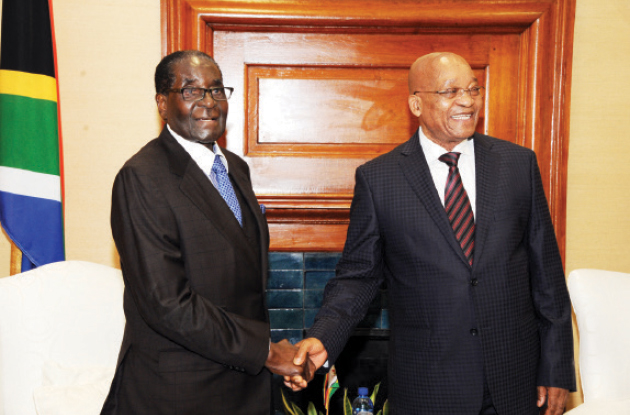Zim, SA confront a shared ghost

Mabasa Sasa in Tshwane
CECIL John Rhodes has a stubborn ghost. It absolutely refuses to be exorcised. More than a century after his death, the poster boy of British colonialism in Africa can still whip up emotions beyond the structural legacy of his vision for the continent as a supplier of raw materials for the Crown and a playground for European sugar daddies looking for a piece of mineral pie.
Yesterday, in a tete-a-tete in Tshwane with President Mugabe before they entered closed-door talks at the start of the Zimbabwean leader’s State visit to South Africa, President Jacob Zuma made a rueful lament about how CJR’s ghost haunts this country of more than 50 million people.
“Cde President,” President Zuma said to the visiting Sadc and African Union chair, “the talk in South Africa right now is about the statue of Cecil John Rhodes, and you know Zimbabwe and South Africa share this man.”
CJR was Premier of the Cape Colony, using this southern-most tip of the continent as the base from which he would launch his dream to paint Africa the red of British Empire right up to Cairo — which included lending his name to the colony across the Limpopo River called Rhodesia.
The Rhodes statue troubling President Zuma is on the campus of Cape Town University, and ever since some firebrand students last month demanded its toppling – now supported by Julius Malema’s Economic Freedom Fighters and the ANC Youth League – South Africans have been bickering as to whether or not this memento to empire should remain in situ.
How this one turns out is anybody’s guess, but it shall have quite a bearing on South Africa’s ideological outlook and exactly what kind of post-apartheid “Rainbow Nation” it is.
CJR, as we all know, made his way across the Limpopo River and ensconced himself quite prettily thousands of miles from the Cape. And he never left, getting himself interred atop Matopos, itself a powerful statement of permanence for anyone who appreciates the cultural significance of those sacred hills.
Every other year, one group or another agitates for the removal of that grave, and President Mugabe says it should be kept there so that CJR’s admirers can fly in and leave their tourist dollars in Zimbabwe – a sort of posthumous tax to try recoup some of the billions the man’s rapacious imperialism spirited out of Africa.
So what was President Mugabe’s response to President Zuma’s lament yesterday?
Leaning reassuringly to his colleague, he said, perhaps a tad laconically, “Well, you have a statue – we have the man himself. I don’t know what you want us to do with him . . . do you think we should dig him up? . . . but perhaps his spirit may rise again. We have decided to keep him down there.”
The symbols of Zimbabwe’s subjugation are everywhere, despite land reforms and economic empowerment.
Even Zanu-PF’s headquarters sit – perhaps as a middle finger to imperialism – near the head of a road called Pennefather Way.
It is a ghost Zimbabwe has started dealing with, it is one South Africa cannot wish away.
This poltergeist one is not going away in a hurry.








Comments